PORT SWITCHING
PROGRAMMING CONSIDERATIONS
Automatic Port Switching
The FormsMaster 8000 series printers will automatically accept data from the Parallel Interface, the
In most installations, the printer is only connected to one computer and this feature may be ignored. In other installations the printer may be attached to two or three computers. This section describes how the printer will automatically switch control of the printer from one hardware interface port to another.
Note that since any one of these ports can become active at any time, items which pertain to each port need to be set up as described in the FormsMaster 8000 Series Operator’s Manual. Ports that will not be used (not installed or not connected to a computer) do not need to be set up. Optional interfaces that are not installed are not displayed in the Setup menus.
When the first data are received at any port after turning on power to the printer, that port becomes the “active” port. While one of the ports is active, each of the other ports will accept only a limited number of characters before reflecting a “busy” condition to the computer attached to those ports.
To change which port is active, the printer’s buffer must be empty for at least 15 seconds and data must be received from a different port. Therefore, if data are never received from more than one port, that port is always the active port.
Programming Considerations
It is the programmer’s responsibility to ensure that the port transitions are achieved in a manner that does not affect their own output or the output from other hosts. This is really no different than running multible programs on the same host with one major exception.
On a single computer, output is generally spooled or one program has to wait until another program has finished with the printer. When multiple host computers are involved, this introduces the ability for one computer/program to interrupt another conputer/program. The printer provides some control of this interruption by requiring the 15 second delay as described above. Programs that may pause for 15 or more seconds before completion should save their output in a file and then copy the data to the printer to protect their output from being interrupted by another host.
To help ensure a “clean” transition when the active port changes, the printer will automatically perform a Carriage Return (CR) and reselect the emulation that was in effect for that port. The default emlation is set in the Interface Setup Menus for the Serial, Parallel, and EtherLink interfaces. The Coax/Twinax and IPDS interfaces default to Printek Emulation.. The printer will also perform a Form Feed (FF) if
109
